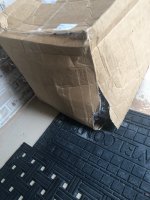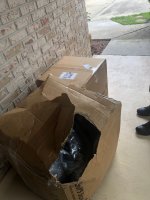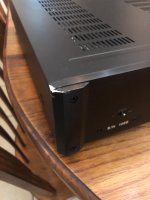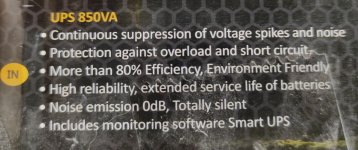I've been thinking of using UPS on my Amplifiers not to power them when there's no electricity but to keep them safe from spikes short circuits , is this a good or bad idea ?
Last edited:
Amplifiers do not need any UPS as they convert power to DC (bus voltage). Any usual spikes (caused by inductive load turn-off) would not even make it through the highly inductive transformer.
However, there may be advantages to powering equipment with HDMI ports from an online (preferable) UPS.
However, there may be advantages to powering equipment with HDMI ports from an online (preferable) UPS.
Ups + anything audio =. Bad bad bad bad bad
I bought two amps
They both are 38 lbs each and they packed them into a 24” x 24” x 24” box . They amps bounces lol around inside that box and damaged one of the amps.
The second photo is what happened when I tried to pick up the box
They guy I bought the amps from though he was doing the right thing by going to the ups store and having them do all the work, what a joke this is turning into.
DONT US UPS



I bought two amps
They both are 38 lbs each and they packed them into a 24” x 24” x 24” box . They amps bounces lol around inside that box and damaged one of the amps.
The second photo is what happened when I tried to pick up the box
They guy I bought the amps from though he was doing the right thing by going to the ups store and having them do all the work, what a joke this is turning into.
DONT US UPS



I've been thinking of using UPS on my Amplifiers not to power them when there's no
electricity but to keep them safe from spikes short circuits , is this a good or bad idea ?
Get a proper AC line filter instead.
Ups + anything audio =. Bad bad bad bad bad
View attachment 985314
I feel your pain. I recently had a Yamaha B-2 shipped to me. Luckily the seller packed it better that your shipper, but it was still loose in the box and the corners of the case are bent in. Mine was shipped through FedEx. They delayed my shipment and updated the tracking info when they felt like it, so I had to go pick it up after waiting all day, but I guess I was "lucky." I'm relieved there was only minor, aesthetic damage. This has to be some sort of conditioned response. 😡
For Americans, yes...
For us in India, with frequent power outages, UPS means a fail safe power supply.
I think the OP also meant what we Indians mean.
Here in India, UPS does not do much business, FedEx, DHL and TNT do.
UPS does not ship to many destinations from here, and has few offices, snotty staff, and is expensive in comparison.
So we thumb our noses at them, and use other service providers.
For us in India, with frequent power outages, UPS means a fail safe power supply.
I think the OP also meant what we Indians mean.
Here in India, UPS does not do much business, FedEx, DHL and TNT do.
UPS does not ship to many destinations from here, and has few offices, snotty staff, and is expensive in comparison.
So we thumb our noses at them, and use other service providers.
Last edited:
As for the OP, no, it is not a good idea to use a fail safe supply, as the supply will be most likely a modified sine wave if on battery, which can cause poor sound on Class AB.
On Class D, the harmonics between the supply switching and Class D switching will be difficult to outright explosive.
Not advised.
Use a good AC line filter, like Rayma said.
OR:
Use a direct battery design, the switching between AC and DC to be done by relay. Battery to lower voltage side of amplifier supply.
Use a car radio based design, easy enough to do.
On Class D, the harmonics between the supply switching and Class D switching will be difficult to outright explosive.
Not advised.
Use a good AC line filter, like Rayma said.
OR:
Use a direct battery design, the switching between AC and DC to be done by relay. Battery to lower voltage side of amplifier supply.
Use a car radio based design, easy enough to do.
Last edited:
Hi . Using UPS for audio depends on audio equipment power supply type (50/60hz trafo or smps) and ups output waveform type ,when working on battery . Problem is when cheap upses produce modified sinewave ,which actually is useless for 50/60hz based transformers and can even damage some equipment , such upses can supply only simple smps based loads like cheap east made power supplies without active pfc ,but no way 50/60hz transformers ,or ac motors,or similar loads. They do produce square wave 50/60hz with pause , which will make transformer make buzz and probably heat ,also voltage on load will depend on load. Another story is with ups ,whose produce "pure sine wave" . You may supply most equipment from such ups , but when operating from battery,they produce some sound few khz ,maybe more , which is part of their pwm operation. This needs to be good filtered if using with audio loads ,because mostly pattial filtering is performed by ups output transformer itself .
Serious question. What is the the point of a UPS (battery backup) for audio equipment? I understand the concept for a computer so you can close out whatever you're working on and shut it down gracefully. For audio equipment, is flipping the power switch (not standby) and pulling the plug that much of a difference?
My Yamaha B-2 manual explicitly says to plug the amp into the wall, by itself. I'm using a surge protector, but trying to limit what stays on, on this surge protector. But then again, this manual was written in the 70s.
My Yamaha B-2 manual explicitly says to plug the amp into the wall, by itself. I'm using a surge protector, but trying to limit what stays on, on this surge protector. But then again, this manual was written in the 70s.
Last edited:
He maybe has something with a long boot sequence, that was not specified in the question.
You point is valid, why does he need music when the power goes off?
You point is valid, why does he need music when the power goes off?
Serious question. What is the the point of a UPS (battery backup) for audio equipment? I understand the concept for a computer so you can close out whatever you're working on and shut it down gracefully. For audio equipment, is flipping the power switch (not standby) and pulling the plug that much of a difference?
My Yamaha B-2 manual explicitly says to plug the amp into the wall, by itself. I'm using a surge protector, but trying to limit what stays on, on this surge protector. But then again, this manual was written in the 70s.
There are 2 types of UPS.
An offline UPS which acts as a failsafe. Great for computers and other equipment that needs to stay powered up when the mains goes down.
An online UPS actually converts mains AC to DC and then generates clean AC. What is an Online UPS? - News about Energy Storage, Batteries, Climate Change and the Environment
I have thought about this years ago, but at the time a good online UPS cost an arm and a leg. No idea if prices have come down. Given the advances in switching power supplies and inverters probably quite a bit. But, how clean is the output?
I was planning to use this one
UPS EUROTECH UPS1500EU SMART 1500VA 900W USB RJ45 SCHUKO Q2
Continuous Power Unit Smart UPS Eurotech with 1500 VA / 900W with protection against voltage variations and current surges. USB port for monitoring Smart UPS via Software. RJ45 Input/Output to protect your network connection against current surges. Efficiency greater than 83% in inverter mode. Three Schuko outlets. Two 8Ah/24V Batteries. Average autonomy of 45 to 50 minutes. Dimension of 34.5 x 14 x 17 cm and Weight of 12.6 Kg.
UPS EUROTECH UPS1500EU SMART 1500VA 900W USB RJ45 SCHUKO Q2
Continuous Power Unit Smart UPS Eurotech with 1500 VA / 900W with protection against voltage variations and current surges. USB port for monitoring Smart UPS via Software. RJ45 Input/Output to protect your network connection against current surges. Efficiency greater than 83% in inverter mode. Three Schuko outlets. Two 8Ah/24V Batteries. Average autonomy of 45 to 50 minutes. Dimension of 34.5 x 14 x 17 cm and Weight of 12.6 Kg.
Last edited:
A true online ups does not connect mains AC directly to the output. It allways rectifies AC to DC and then generates AC.
The APC Smart UPS series is a so-called line interactive. This one is probably similar. Effectively an offline ups that can interact with the mains. It does this to add a bit when the power sags etc but it is not a true online ups.
I have used APC Smart UPS for years for servers. I would not consider one to clean up AC for an audio system.
The APC Smart UPS series is a so-called line interactive. This one is probably similar. Effectively an offline ups that can interact with the mains. It does this to add a bit when the power sags etc but it is not a true online ups.
I have used APC Smart UPS for years for servers. I would not consider one to clean up AC for an audio system.
Last edited:
TSi Power, USA
Look it up
India ops:
Application Areas - TSi Power (P) Limited, Vadodara, Gujarat, India
IGBT based power supply and voltage controllers, very high quality.
This is the type you need.
Response time 15 milliseconds typically, output controlled to within 1 Volt, line noise filters are built in, very clean AC power output.
They use top quality - Fairchild is normal - IGBTs, rest of the material is top class as well.
Look for something like this, and if you can afford it, use one for the entire house. The control circuit is expensive, a bigger unit is proportionately cheaper, not in multiples of rating.
Earlier designs of voltage controllers used relays, triacs and so on for tap changing.
You also get ferro resonant and servo motor type voltage stabilizers (the local description is that).
This is a new way, IGBT drives the output.
Look it up
India ops:
Application Areas - TSi Power (P) Limited, Vadodara, Gujarat, India
IGBT based power supply and voltage controllers, very high quality.
This is the type you need.
Response time 15 milliseconds typically, output controlled to within 1 Volt, line noise filters are built in, very clean AC power output.
They use top quality - Fairchild is normal - IGBTs, rest of the material is top class as well.
Look for something like this, and if you can afford it, use one for the entire house. The control circuit is expensive, a bigger unit is proportionately cheaper, not in multiples of rating.
Earlier designs of voltage controllers used relays, triacs and so on for tap changing.
You also get ferro resonant and servo motor type voltage stabilizers (the local description is that).
This is a new way, IGBT drives the output.
Last edited:
My molding machine has a transformer with different primary tappings, 0-200/220/240 V , and a 200 V secondary.
Primary is connected at site after checking supply voltage, this is done by the installing engineer, who selects the input tap to be used.
750 VA, used for the control circuit.
Works as a noise filter / isolation transformer.
The theory is that most noise is not continuous, and magnetic hysteresis absorbs and dulls the noise, preventing it from being induced in the secondary.
That would work too.
Primary is connected at site after checking supply voltage, this is done by the installing engineer, who selects the input tap to be used.
750 VA, used for the control circuit.
Works as a noise filter / isolation transformer.
The theory is that most noise is not continuous, and magnetic hysteresis absorbs and dulls the noise, preventing it from being induced in the secondary.
That would work too.
Last edited:
I've used a 300VA UPS on a Belcor tube amp. Not only did it work, it didn't hum because the filters worked better for "stepped sine" than real sine.
Unless you have frequent power failures though, use the UPS for a computer or something that should be shut down properly.
Unless you have frequent power failures though, use the UPS for a computer or something that should be shut down properly.
- Home
- Amplifiers
- Power Supplies
- Using UPS on Amplifiers good or bad idea ?
